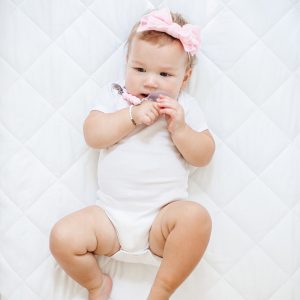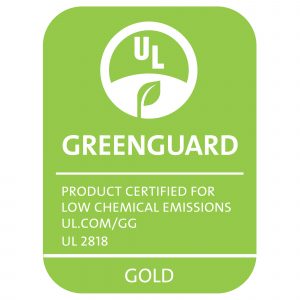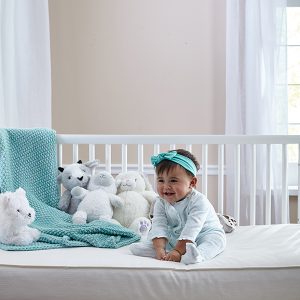Clean air and clean nursery can mean a healthier and happier baby!

When babies are first born, their immune systems are still developing. When they are older, both internal and external environments can impact their well-being. While you can’t control mother nature, eliminating allergens in the nursery goes a long way towards keeping them healthy and safe. In addition to reducing pet hair and keeping windows closed to reduce airborne pollen, selecting the right bedding and crib mattress makes a huge difference. Keeping your baby’s nursery clean and fresh can help eliminate bed bugs, dust mites, and more.
Here are 7 tips to help limit the number of allergens and asthma instigators in your baby’s nursery!
1. Wash Bedding Often
Washing your little one’s sheets and pads at least once a week (more if needed) can help to remove dust mites and other allergens that can cling to bedding. Avoid using scented dryer sheets, as these have the potential to irritate baby’s sensitive skin; look for hypoallergenic ones. Buy at least 2-4 fitted crib sheets and 2-3 crib mattress pads for back-up when baby’s bedding is in the wash.
2. Use a Crib Mattress Encasement
Protect your infant or toddler’s mattress from bed bugs, dust mites, and other household allergens. A crib mattress encasement helps guard against bed bugs and other asthma instigators by fully zippering around the mattress. Look for crib and toddler mattress encasements that are laboratory tested and approved to ensure 100% bed bug protection.
3. Help Keep Baby’s Air Cleaner
Air purifiers and humidifiers keep the air in baby’s nursery cleaner and fresher. A purifier helps to remove airborne dust, pet dander, and pollen from the air, while a humidifier prevents dryness to help baby sleep better at night. If the room is too moist, a dehumidifier can eliminate moisture and help prevent mold. Only use purifiers and humidifiers for a limited time period and avoid aiming them at baby’s crib or dresser to prevent damage to wood furniture. Keeping windows and doors closed can help prevent allergens from coming into the home and baby’s bedroom.
4. Look for GREENGUARD Gold Certified Crib Mattresses
When shopping for baby’s crib mattress, look for ones that are GREENGUARD® GOLD Certified for indoor air quality and low chemical emissions to help create a healthier indoor environment for your little one. The GOLD standard is a more stringent test, ensuring a safer product for infants and toddlers.
5. Regularly Dust and Vacuum
To keep dust mites and other allergens at bay, vacuum and dust baby’s nursery often. Vacuuming and dusting 1-2 times a week can help to eliminate allergens in the nursery and keep it fresh and clean.
6. Use Hypoallergenic Bedding
In addition to crib mattress encasements, crib mattress pads made with hypoallergenic materials can help eliminate allergy triggers. Look for mattress pads with waterproof barriers, natural cotton materials, hypoallergenic cushioning, or tightly woven covers for extra protection against asthma instigators in baby’s nursery.
7. Wash Stuffed Toys Regularly
Stuffed toys can sometimes be a breeding ground for mites, mold, and other germs. Washing your little one’s stuffed toys weekly can help keep them clean and free of germs and other allergens. Be sure to also keep stuffed toys out of baby’s bed — not only does this help create a safe sleep environment for them, but it also prevents allergens from transferring from the toy to baby’s crib.
Shop the Story
Sealy Allergy Protection Fitted Crib Mattress Pad with Organic Cotton Top
A double layer of allergy protection with an organic cotton surface provides natural softness on baby’s mattress.
Sealy SafetyCase Protective Crib Mattress Encasement
Lab tested and approved 100% bed bug proof encasement
Sealy Allergy Protection Plus Fitted Crib Mattress Pad
Allergist recommended micro-weave top layer helps guard against dust mites, pet dander and other asthma instigators







